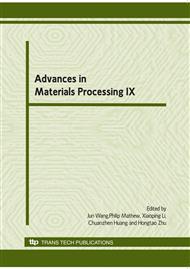p.250
p.256
p.262
p.268
p.274
p.279
p.285
p.291
p.297
Finite Element Simulation of Chip Formation during High-Speed Peripheral Milling of Hardened Mold Steel
Abstract:
The modeling and simulation of chip formation during high speed milling of hardened mold steel are systematically studied by the Finite Element Analysis (FEA). The modified Johnson-Cook’s constitutive equation for hardened mold steel is introduced. Comparing to the experimental results, the simulated results of cutting force, chip morphology, effective stress and cutting temperature in deformation zones of high speed peripheral milling indicate good consistence and the models established can be used to accurately predict the behavior of hardened mold steel.
Info:
Periodical:
Pages:
274-278
Citation:
Online since:
June 2010
Authors:
Price:
Сopyright:
© 2010 Trans Tech Publications Ltd. All Rights Reserved
Share:
Citation:


